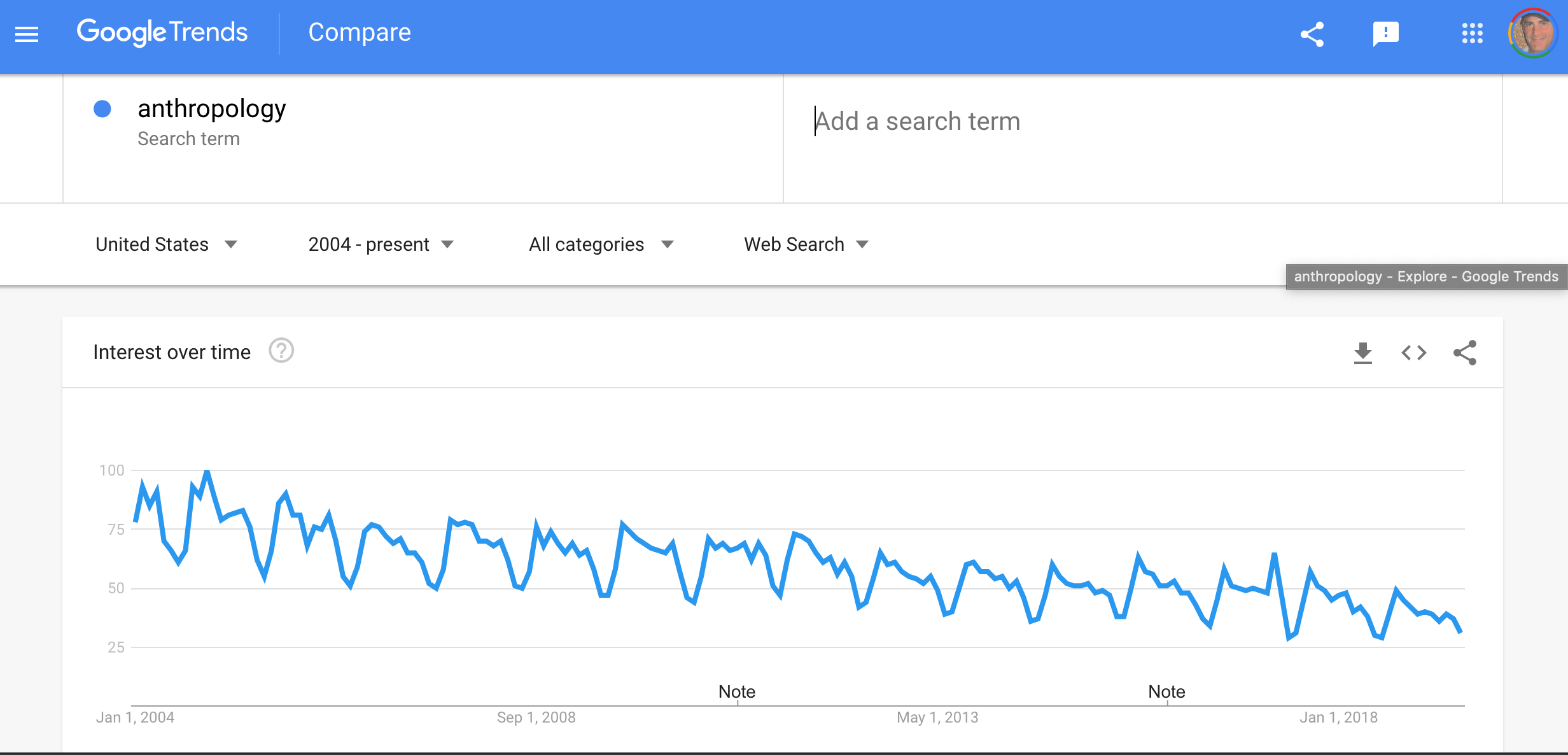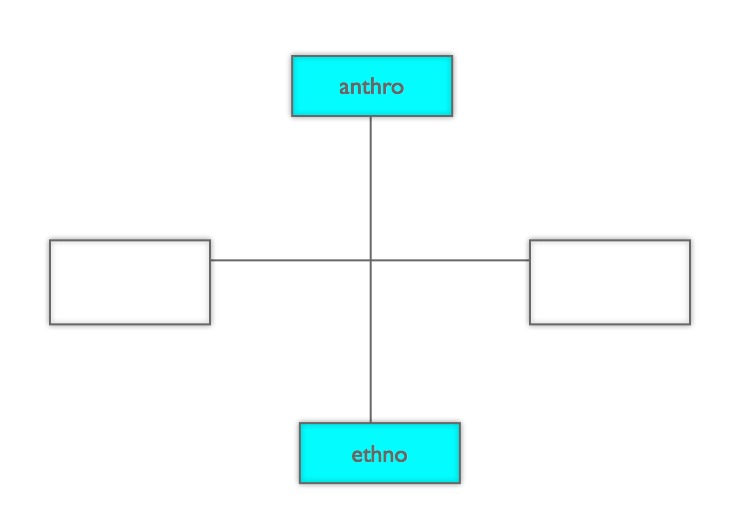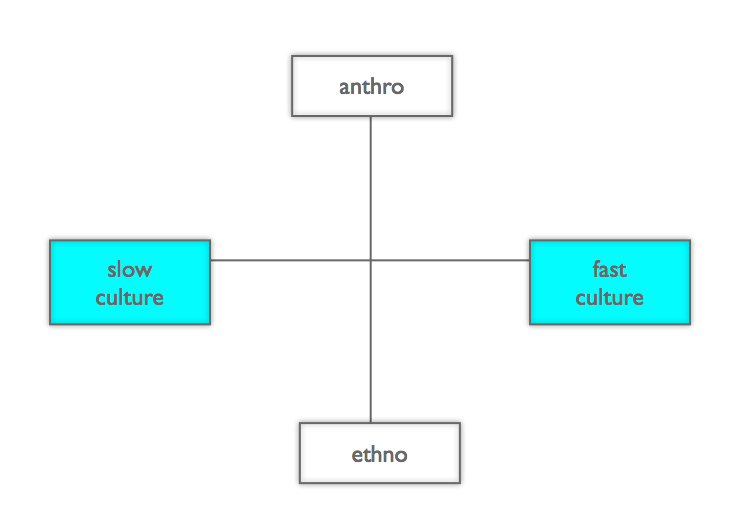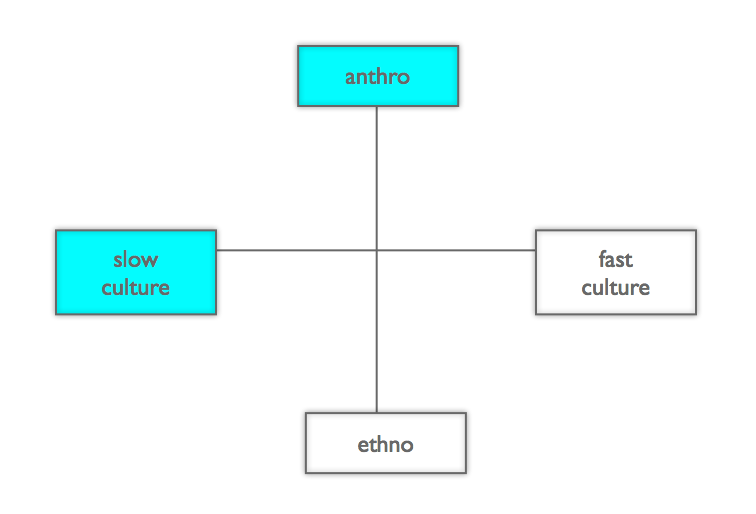As the academic world continues its slow motion descent into financial and sometimes intellectual insolvency, some anthropologists seek employment in the world of business.
The Journal of Business Anthropology asked me to describe my experience. Here is what I wrote for them.
But first, here’s an image from the field. It’s me talking to respondents who were too busy to sit for an ethnographic interview. “That’s ok,” I said. “I can interview you at the gym.” In the world of business, anthropology thy name is opportunism.

Just In Time
How to be an anthropologist in business
I assume I am talking to anthropologists who spend some, much, or most of their career outside the academic world. I assume that my job is to offer advice on one of the ways this can be done.
For starters, I should say that I don’t think of myself as a business anthropologist. My plan was to use business consulting to finance my anthropology.
I consult half the year and write half the year. The first half pays for the second. COVID was going to make my income disappear. I don’t have much of a cushion. Bankruptcy now beckoned.
What COVID threatened to take away, it would also give, I hoped, in the form of an opportunity to study the American family in a moment of confinement. I’ve studied this family for some 30 years, with particular attention to its material culture and build form. I look in from time to time, most recently to figure out that “what” and the “why” of the great room.
Surely COVID would test this family and home. Surely it would force deformation and reformation. This is the first revelation of studying the American family and home. They are feverish works in progress. Americans are here, as elsewhere, fly-by-the-seat-of-their-pants inventors.
My favorite example: an African American single mother of modest means who had used her local zoo as a place to amuse and instruct her kids (a pre-teen boy and girl). COVID closed the zoo. So she bought a guinea pig which she told me did a surprisingly good job standing in for the zoo. (I remember putting the phone down and having a good cry.)
So the intellectual opportunity was obvious: I could go see what COVID would mean to the family. What was happening to house, home and kinship under these extraordinary stresses?
But unless this study was also a commercial opportunity I was done for financially. Surely, I thought, industry would want to know what was happening in the family. And for the first time in my career, I was soliciting work instead of waiting for it. Plus I was undertaking my anthropological work for commercial return. (Normally, I merely solve the problem the client has for me…and return to an anthropology that’s entirely my own.)
The work returned many points of interest. The most striking finding was that mothers and daughters had found one another. Mothers said, “I have my daughters back.” They meant back from college and back from the preoccupations, digital, social and athletic, of being a teenager and a preteen. Mothers and daughters were, they said, “talking, sharing, connecting.” (I think this may leave us with a new degree or kind of matrifocality.)
It turned out industry didn’t much care. No one wanted to hear what I had learned. I got some press (Wall Street Journal and Washington Post, links below). And still no one in industry cared to hear what I had to say. (FN: https://www.wsj.com/articles/how-covid-19-lockdowns-have-boosted-mother-daughter-bonds-11600804296; https://www.washingtonpost.com/lifestyle/2020/10/30/mothers-raise-kind-daughters-covid/)
Moms were clearly the heroes of these scenarios. Guinea pigs were just the beginning of their creativity. Building new relationships with the daughters were not be any means their biggest accomplishment. Mom (when it was a mom) got the family through a horrible time.
I mentioned “mom heroism” to anyone who would listen: friends, colleagues, journalists. Their response was surprise. People seemed to say, “But this is what moms do.” And clearly it is what moms do, but it remains I think odd that they should get so little credit. Even in this time of peril, even as they did heroic things, what they got was “That’s moms for you.”
A note on method
You see things like guinea pigs standing in for a zoo, and moms rising to the occasion, fleetingly, because nothing happens in the consulting world that’s not a blur. It is only because you will go back to the same terrain, and because ethnography comes with an “extra data” opportunity, that we can use consulting work for anthropology purposes. (FN: https://cultureby.com/2006/09/ethnography_and.html.)
“Fleetingly” is pretty much our modus operandi as anthropologists in business. We are trained to dwell, interrogate, contextualize and variously worry the data until it’s thinkable and then presentable. Anything less invites the scorn of our colleagues and a certain self loathing. Indeed, “fleetingly” so contradicts our academic training that it can feel like a betrayal of private hopes and public responsibilities.
We are in effect learning to live like journalists. We are moving at speed from “story” to “story.” But anthropologists have an advantage: they are scrutinizing the world from an organizing, X-raying point of view. Systematic properties reveal themselves. And we are working not with events frothing on the surface of public life, but with more enduring materials (e.g., cultural categories). Finally, while we will work for many clients who ask a variety of questions, we return again and again to some of the same topics (e.g., American family and home). Most of the people with whom we compete in the research and consulting world practice amnesia. We gather as we go.
To say we resemble journalists and, to that extent, disappoint our missions as anthropologists, is indeed one way to look at it. We could also see our predicament as a trade off. Certain opportunities are denied us. But others are now possible.
Those who do business anthropology learn to work at speed. We can’t make a living unless we are prepared to capture data, work out understandings, conclusions and recommendations, and write these up, all more or less in real time. There’s no time for taping or transcription. There is precious little time to dwell. Lean in? We are pitched forward, obliged to watch topics constantly pulled away from us by the current. We can’t help feeling there are riches here if we only had time to examine them.
The advantage is that we learn to work fast. I wrote two books during the COVID period, thanks chiefly to my consulting training. One was called the The New Honor Code (Simon and Schuster 2021). The second is The Return of the Artisan (Simon and Schuster forthcoming 2022). (I wanted to call it The Return of the Native, but apparently that was taken. I kid.)
The first book is a piece of applied anthropology. As a grad student at the University of Chicago, with Marshall Sahlins (he of sainted memory) as my advisor, I studied Elizabethan England. This was interesting fieldwork for lots of reasons. It helped me see an honor code at work. And as I began to see bad behavior break out in American culture, I wondered “is there something in the Elizabeth case we could reengineer for use in the contemporary world.”
There is a presumption here that was new to me. Writing a book that aimed to change American culture? Surely, my job was to study culture, not reform it. But the more you study American culture, the more you see how responsive it is to individual initiative. (How else to understand Gloria Steinem, Tom Wolfe, Virgil Abloh, well, and for that matter, Margaret Mead?)
I wrote Honor in real time, piecing things together in my head as I went. This is “just in time” assembly I couldn’t imagine before consulting had transformed me. I am the graduate student who spend an entire weekend on a single paragraph, not because I was scrupulous, but because I was such a very bad writer.
Just in time assembly means you work with available materials. In my case that meant drawing on a career thinking about American culture on the grounds that “if honor is to be restored, it will have to find a place for itself in the present sea of cultural and moral innovations.” This gave me license to treat the American avant-garde, mid century modernism, the hippy revolution, the preppie rejoinder, the artisanal movement, celebrity culture, the rise of the millennial, the Gen Z rejoinder, and changing models of American selfhood, sociality and story telling.
You’d be surprised how useful these materials can be to a man who has to come up with 60,000 words in a very months. I was. And grateful. Surely we are done with authors who offer bold new reform with no thought to the American culture it must join if it has any hope of adoption. Otherwise we’re left with an ideational accumulation, a thing of threads and patches. Patches, mostly. We inhabit a culture that’s fast losing the integration Boasians, and some of the rest of us, held dear.
To write a book fast you need the right voice. And I think consulting gives us this too. We are writing for non anthropologists, non academics and people who are haunted by deadlines and targets. This means we learn to aim for clarity. For the Honor book, I decided to go for a kind of high-polish exposition relieved here and there by informality.
Here’s a passage. (It is part of my description of the Tilbury speech delivered by Elizabeth I on the eve of the attack by the Spanish armada in 1588. Honor played a key role, not in evidence here.) See what you think.
In the sixteenth-century scheme of things, England was little and vulnerable. The troops at Tilbury were hungry, underpaid, and properly terrified. By the Spanish standard, this island was poor, provincial, and home to hundreds of thousands of Catholic sympathizers who had been encouraged to rise up in support of the enemy.
Elizabeth’s Tilbury speech was theater in the service of statecraft, infinitely more compelling than the amateur production being staged in the channel by foppish aristocrats firing off conflicting instructions. (The commander of the armada, the Duke of Medina-Sidonia, had never fought at sea.) The Spanish called their armada invincible. Elizabeth had come to Tilbury to say, “No, actually, this is what invincible looks like. My courage will triumph over your titles and grandeur.” This is Elizabethan for “Bring it.”
There are a couple of rhetorical strategies the normal anthropologist would never use. The ‘word painting’ that stands in for patient review of data and argument. The total eclipse of scholarly reference. (Normally, available only to the Geertzian aristocrats among us). The sneering at foppish aristocrats. The daring, off-with-his-head, presumption of putting words in the mouth of a monarch who was the flower of Renaissance humanism and a master rhetorician. The last line is especially cringe worthy. But this was my effort to bring in the reader by being a little less, actually anti, oratorical.
I am behaving in a way that would horrify the academically scrupulous. The idea is to sacrifice rigor for approachability and agreeability. Consulting has helped me see that this is less a choice than an obligation. Yes, there is something a little shocking about the anthropologist who fails to “ping the tower” of scholarship as he goes. But the reader unfreighted by scholarship can make better speed and accomplish real distances. Does she survive these compromises without undue harm? I guess she has to make this decision for herself.
And this last point is a gift of consulting too: that I don’t presume to anticipate all of the needs or reactions of my reader. I look to be useful, interesting, illuminating and clear, and leave the rest to them. Yes, I am not scrupulous. We are, anthropologists are, these days sometimes perhaps preoccupied by scruple. This makes our work tough sledding for the general reader. They say, “Sorry, what? Oh never mind.”
The second book was called Return of the Artisan. It sprang from the Artisanal Economies Project (AEP) that Sam Ford and I founded a couple of years ago. Sam and I had met through Henry Jenkins’ Convergence Culture Consortium at MIT and at some point we started thinking about what we could do to help address the opioid abuse then (and still) raging in the US.
Our idea was to make artisanal activity a way to address lost industrial employment, a bulwark against the despair that sometimes follows unemployment, and the addiction that sometimes follows despair. Could we help induct people into the artisanal economy? We hoped that even a tentative engagement there might sustain self confidence and community connection. (Artisanal economies are very social and collaborative creatures.)
Sam and I did research across the US, much of it in the Midwest and South. We put together an elementary website at http://www.artisanaleconomiesproject.org, a kind of “lazy susan” of options. We hoped people would scroll through and find something of interest, start small, and scale up. The project failed to generate much interest and it didn’t draw the funding we needed to push the project further. (We had funded the research and the website out of our own pockets and those resources were now beginning to empty out.)
Now the issue was salvage. (Opportunism must sometimes be the business consultant’s middle name.) I had been working on the topic since 2006 and Sam suggested I think about combining that work with the AEP data, and create a book.
Before consulting, it never occurred to me to start an organization like AEP. My engagements with the world came in the form of books and articles. The university was my exoskeleton. If I was to have any kind of influence, it would be through my students and their students. Marshall Sahlins is an exemplar here. (I am one of his influences, a modest one to be sure.)
But what if what you need to engage the world more directly? Then you are in the “start up game,” as they call it in Silicon Valley. That’s a very different kettle of fish. And yet another learning curve. And, just to mix my metaphors thoroughly, a recipe for disappointment. Creating an organization is really to reckon with the crooked timber truth of humanity. Nothing is simple. Because (new metaphor alert!) humans really are cats and, as the phrase has it, impossible to herd.
But you can start a business. As a consulting anthropologist you have met and worked for lots of people who have created organizations. This removes most of the mystery and all of the awe. There’s lots of precedent and, if you ask for it, advice.
Starting an organization concentrates the mind. If you make a success of it, you may also get an “equity payday” when you get “bought out.” I have preferred to treat books as the big ROI that would see me into my retirement. I’m still waiting. Honor didn’t have a natural audience. Return might.
The artisanal story was really fun to tell. Again I’ve used a convivial prose. See what you think.
It’s a shocking thing to think. We’ve become habituated to the idea of office work. For years this had been the aspiration of almost everyone with a college degree. We got so very good at committee meetings, office speak, annual reviews, feel-good picnics, and morale building exercises, it’s a wonder we got any work done at all.
So a new model of work, this catches our attention. The artisan doesn’t have a suit to wear to work. She didn’t have an office or a parking space. She didn’t lie awake at night and worry about promotions. Her annual review is going to a local cafe with a friend and asking, “So how am I doing, do you figure? Be honest.”
The Artisan book shows some of the symptoms of hasty construction. In the place of a single grand model, I identify 24 properties. These stretch from “hand made” and “human scale” to “unbranded” and “storied.” These represent a shameless piling system. I stopped when I thought I might have covered everything. Here too integration got short shift.
Even in haste, there were wonderful things to notice. There was the strange duality of the artisanal economy. Especially, as we saw it operating in Kentucky, it was, my phrase, not theirs, “a grid below and a dome above.” People see themselves and their enterprises as emphatically free standing. They do not ask for support or succor. But they are constantly throwing off acts of generosity designed to serve the larger community. We interviewed a farmer who keeps an exotic species of sheep. He will never recover the costs of doing this, but he believes this matters to the community. In the “grid below,” advantage is calculated and pursued, steelyly, so to speak. Everything is counted. In the “dome above,” everyone gives and takes freely. No books are kept. No debts are registered. Nothing is owed.
This is direct and indirect exchange in a perfect laminate, discrete economies that operate almost without contact or mutual acknowledgement. When you ask why people give so generously to the community, the answer is various: God, church, community, caring. But usually the answer was “Kentucky.” I pursued this and was eventually told, “Kentucky is the only place that gives you a tattoo on the inside.”
Anthropologists have lots of natural advantages. It has tattooed many of us on the inside. This gives us a chance to carry our professional identity into our consulting life and, with the appropriate adaptations, serve our culture with an understanding of our culture they cannot get from any other social scientist, journalist, or helping professional. I don’t say that Durkheim, Boas, or Sapir would look at my career and register even a flicker of recognition. But as I was leaving the academic world, I thought, “What could it hurt to pitch one more anthropologist into the world?”
It’s a long shot but not a bad bet. And it cost the field nothing. This is one of the reasons I am sorry that the field has not supported consulting anthropologists more. Yes, of course, seen by unexamined assumptions, the consultant is the apostate. On the other hand, this experiment can advance the anthropology of American culture. And this culture needs all the friends it can get.
Bio
Grant McCracken is a cultural anthropologist. He holds a PhD from the University of Chicago. He is the author of 14 books including The Return of the Artisan to be published by Simon and Schuster in July. He was the founder and Director of the Institute of Contemporary Culture at the Royal Ontario Museum. Grant has taught at Harvard, University of Cambridge, and he was a member of the Convergence Culture Consortium at MIT. He is a co-founder of the Artisanal Economies Project. He is the inventor of The Griff, an early warning system for social and cultural change. He consults widely, and his clients include Google, Ford Foundation, Kanye West, Netflix, Reddit, Sony, Boston Book Festival, NBC, IBM, Nike, and the Obama White House. For several publications: https://linktr.ee/grant27
Originally published:
McCracken, Grant. 2022. Just in Time. Journal of Business Anthropology. Vol. 11, No. 1. https://doi.org/10.22439/jba.v11i1.6617.





 Charlie Rose recently interviewed George Lucas. At the 16 minute mark, we see these two great men cross swords.
Charlie Rose recently interviewed George Lucas. At the 16 minute mark, we see these two great men cross swords. The shouting! The hyperbole! The balloons!
The shouting! The hyperbole! The balloons! Several weeks ago, Mark Bernstein announced the latest Tinderbox, the “tool for notes.”
Several weeks ago, Mark Bernstein announced the latest Tinderbox, the “tool for notes.”


 Several months ago, Robert Fogarty asked if I wanted to contribute something to a special issue of The Antioch Review called “The Future of Museums.”
Several months ago, Robert Fogarty asked if I wanted to contribute something to a special issue of The Antioch Review called “The Future of Museums.”




 A note on style: I wrote this in a hotel room somewhere. I used
A note on style: I wrote this in a hotel room somewhere. I used 

 This is a photograph of Sara Little Turnbull (1917–2015). Sara was an designer and anthropologist. In 1988 she founded, and for 18 years she ran, the Process of Change Laboratory for Innovation and Design at the Stanford Graduate School of Business.
This is a photograph of Sara Little Turnbull (1917–2015). Sara was an designer and anthropologist. In 1988 she founded, and for 18 years she ran, the Process of Change Laboratory for Innovation and Design at the Stanford Graduate School of Business.